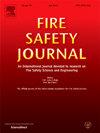Research on the mechanism of surfactant-enhanced water mist suppressing liquid pool fire
IF 3.4
3区 工程技术
Q2 ENGINEERING, CIVIL
引用次数: 0
Abstract
Water mist (WM) is widely used to suppress various liquid fires due to its numerous advantages. In order to enhance the suppression ability of WM, additives have become an effective means. In this study, we selected three surfactants as additives for WM, chose ethanol, gasoline, and cooking oil as the suppression targets, conducted comparative experiments, and analyzed the suppression mechanism based on the experimental results. For ethanol pool fires, the most effective inhibitor is 0.01 % FS-51, while the least effective is 0.01 % 1-heptanol for gasoline pool fires, the most effective inhibitor is 1 % CAB-35, while the least effective is 0.01 % 1-heptanol; for cooking oil pool fires, the most effective inhibitor is 1 % CAB-35, while the least effective is pure WM. Based on the suppression results, combined with the fuel characteristics and the surface active agent characteristics, the addition of surface active agents mainly affects the surface tension and foam properties of the WM, the combination of which can better suppress liquid pool fires. Among them, the change in surface tension will affect the specific surface area and momentum of the mist droplets; the foam properties include foaming ability and foam liquid content.
表面活性剂增强水雾灭火机理研究
水雾由于其众多的优点,被广泛应用于扑灭各种液体火灾。为了提高WM的抑制能力,添加剂已成为一种有效的手段。本研究选取三种表面活性剂作为WM的添加剂,选择乙醇、汽油和食用油作为抑制目标,进行对比实验,并根据实验结果分析其抑制机理。对于乙醇池火灾,最有效的缓蚀剂是0.01% FS-51,最不有效的是0.01% 1-庚醇;对于汽油池火灾,最有效的缓蚀剂是1% CAB-35,最不有效的是0.01% 1-庚醇;对于食用油池火灾,1%的CAB-35是最有效的抑制剂,而纯WM是最不有效的。根据抑制结果,结合燃料特性和表面活性剂特性,表面活性剂的添加主要影响WM的表面张力和泡沫性能,两者结合可以更好地抑制液池火灾。其中,表面张力的变化会影响雾滴的比表面积和动量;泡沫性能包括发泡能力和泡沫液含量。
本文章由计算机程序翻译,如有差异,请以英文原文为准。
求助全文
约1分钟内获得全文
求助全文
来源期刊

Fire Safety Journal
工程技术-材料科学:综合
CiteScore
5.70
自引率
9.70%
发文量
153
审稿时长
60 days
期刊介绍:
Fire Safety Journal is the leading publication dealing with all aspects of fire safety engineering. Its scope is purposefully wide, as it is deemed important to encourage papers from all sources within this multidisciplinary subject, thus providing a forum for its further development as a distinct engineering discipline. This is an essential step towards gaining a status equal to that enjoyed by the other engineering disciplines.
 求助内容:
求助内容: 应助结果提醒方式:
应助结果提醒方式:


